The Jaboticaba (Myrciaria cauliflora, Eugenia cauliflora, Plinia cauliflora) is a tropical shrub to tall tree native to Brazil and Bolivia. It is best known for its large, spherical, dark purple fruits that grow directly from the trunk. The fruits of Jaboticaba are available in Brazilian markets which are delicious both raw and cooked.
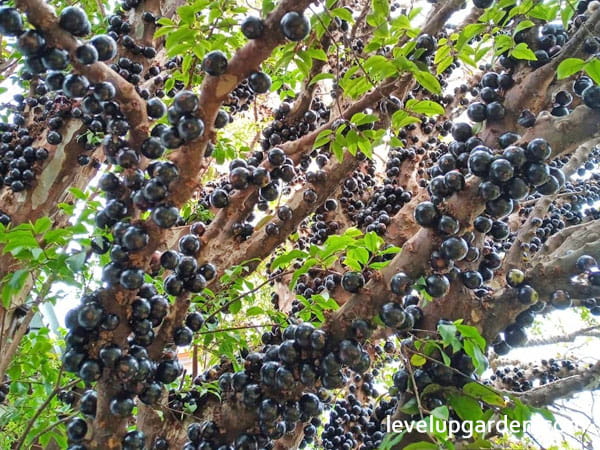
I. Plant Profile – An Overview of the plant
| Common Name | Jaboticaba, Brazilian Grapetree, Jaboticaba, Jaboticaba Tree |
| Botanical name | Myrciaria cauliflora, Eugenia cauliflora, Plinia cauliflora |
| Type | Broadleaf evergreen |
| Family | Myrtaceae |
| Genus | Plinia |
| Species | cauliflora |
| Family | Myrtaceae |
| Native Range | Southeastern Brazil |
| Zone | 10 to 12 |
| Height | 10.00 to 25.00 feet |
| Spread | 8.00 to 20.00 feet |
| Bloom Time | Seasonal bloomer |
| Bloom Description | White |
| Sun | Full sun |
| Water | Medium |
| Maintenance | Medium |
II. Appearance
Jaboticaba grows up to a size of 10 to 25 feet tall, densely covered, and rounded in shape. It grows lanceolate to elliptic, leathery, opposite, evergreen leaves (1 to 4 inches long) that have a shiny, dark green color. Its yellowish-white flowers are borne in clusters on the trunk and branches. The flowers are followed by spherical purple fruits (average diameter 1 inch) that appear singly or in clusters.

Moreover, the trees may produce flowers and fruit multiple times throughout the year. A flavorful pulp can be squeezed out by pinching the fruit between the thumb and forefinger. The skin is edible but contains high levels of tannins.
Jaboticaba Tree has a fruit that is round, thick-skinned grape-like fruit with sweet, white flesh. Like the flowers, the fruit is borne along the trunk and branches. Under optimum conditions, fruits of Jaboticaba can be seen from 5 to 6 times a year. The best way to produce fruits of these trees is through pollination.
Its flowers are a faint white color, and the dark cherry-like fruit can be eaten right off the tree or made into preserves or wine. Fruits are single or densely packed, green at first, dark purple to almost black when ripe. The fruits have a size of about 1 inch (2.5 cm) in diameter.
III. Growing and Care Conditions
Jaboticaba (Myrciaria cauliflora) is an unusual fruit tree that produces fruit along the bark of the tree. It is generally grown outdoors without winter protection in USDA growing zones 10-12 but is also suitable for container growing in cooler climates. It is a slow growing plant, reaching 30-40 feet tall and 15-20 feet wide when planted in the ground, but more compact when grown in a container. When potted, it needs to be replanted before nighttime temperatures drop to nearly 40°F, but it can tolerate temperatures as low as 30°F.
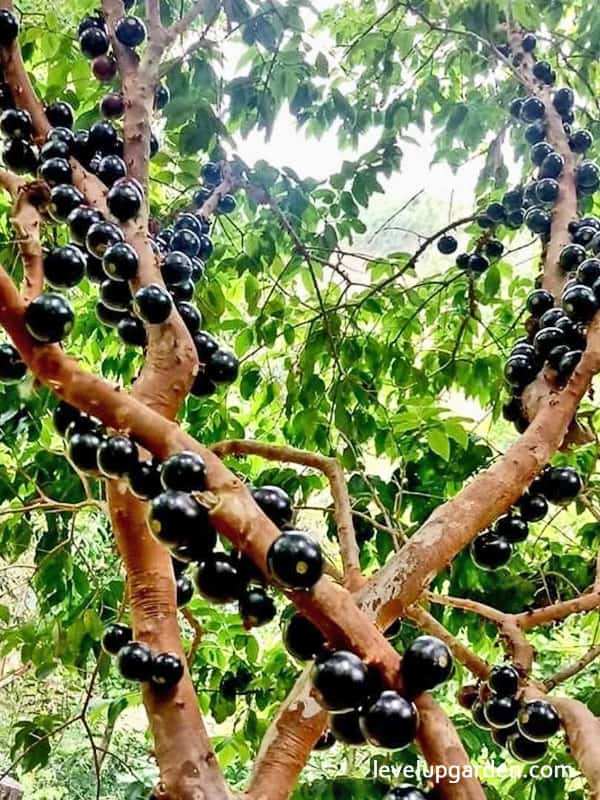
Planting
Jaboticaba is a sunny tree but can also tolerate a little shade. It prefers well-drained soil with a pH of between 5.5 and 6.5. It is not salt or wind tolerant and should be protected from these elements, especially when young.
Light
Jaboticaba trees can survive in full or partial sun. Though, they may grow well in a location with partial shade in the first few years. The Jaboticaba bonsai tree can be grown indoors with high exposure to light.
Watering
It is not good for Jaboticaba to have its feet wet. But, it should be watered regularly while it is being planted to help it establish roots and prevent it from dying. Whether planted in the ground or in containers, do not water the plant, but allow the soil to dry to about 2 cm.
Fertilizer
Due to Jaboticaba’s slow growth, it is good to apply a balanced fertilizer such as 10-10-10 in the spring and summer. This induces growth during the first two to three seasons. Another option is to layer compost on top of the roots in the spring.
Soil Requirements
Jaboticaba trees grow well in rich, well-drained soil from sun to shade. Although it is not frost tolerant, it can be grown as a bonsai for bringing indoors when winter temperatures drop too low, or as a mixed plant. Coastal areas tend to be warmer, but it does not tolerate salt damage.
Temperature
Cold tolerant to USDA zones 10-12, the best site is in deep, well-drained, acidic soil in sun to shade.Always maintain constant humidity. It grows best in frost-free climates, but will tolerate occasional light frosts. It will not tolerate temperatures below 26 degrees F. It will tolerate temperatures below 30 degrees F.
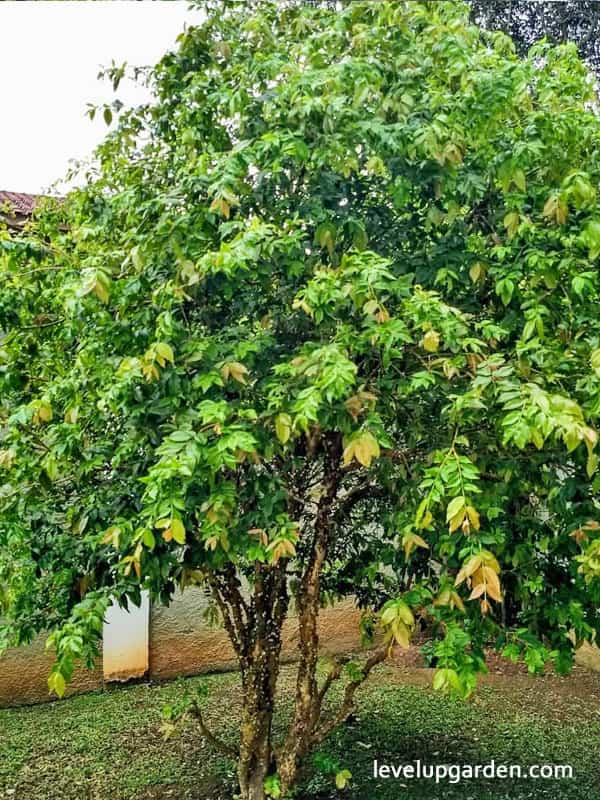
Pruning
Pruning jaboticaba is best done by removing broken, dead, or crossed branches. It is also effective to remove stems and leaves growing in the center of the tree. Jaboticaba produces flowers and fruit on its bark, so removing growth in that area will improve flower and fruit production. However, it may grow well with minimal pruning each year.
Pests and Diseases
There are no major diseases, but it can suffer from rust and mildew when humidity is high. This is the most common disease in Brazil, the initial signs are circular spots that are color yellow which turns into dark-brown. It is also prone to pests like fire ant, queensland fruit fly, and others.
Pollination
Jaboticaba trees are self-fertilizing; one sapling can produce fruit. However, adding another jaboticaba tree will greatly increase the size of the harvest. It is known that cross-pollination is the best way to have a plentiful harvest.
IV. Uses
The purple-black, white-fleshed fruit, which grows directly on the trunk, can be eaten raw or used to make jelly, jam, juice, wine, etc. Jaboticaba Tree can also be grown as a bonsai. It grows slowly and is small when immature, making it a popular bonsai and ornamental plant in temperate regions.
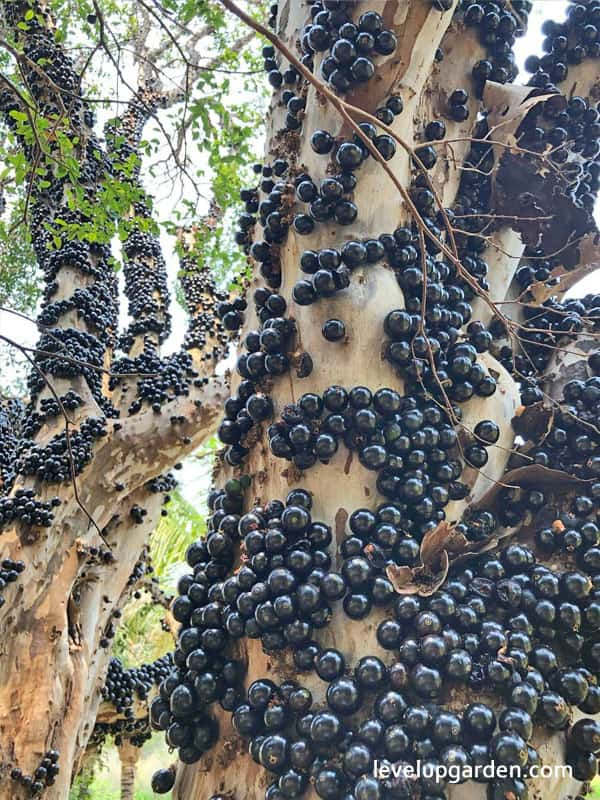
V. Why should you buy this plant
Jaboticaba can add an exotic look to your garden. The jaboticaba, also known as the “Brazilian grapevine,” produces a profusion of dark-colored berries on its bark that are halfway between grapes and plums in size.
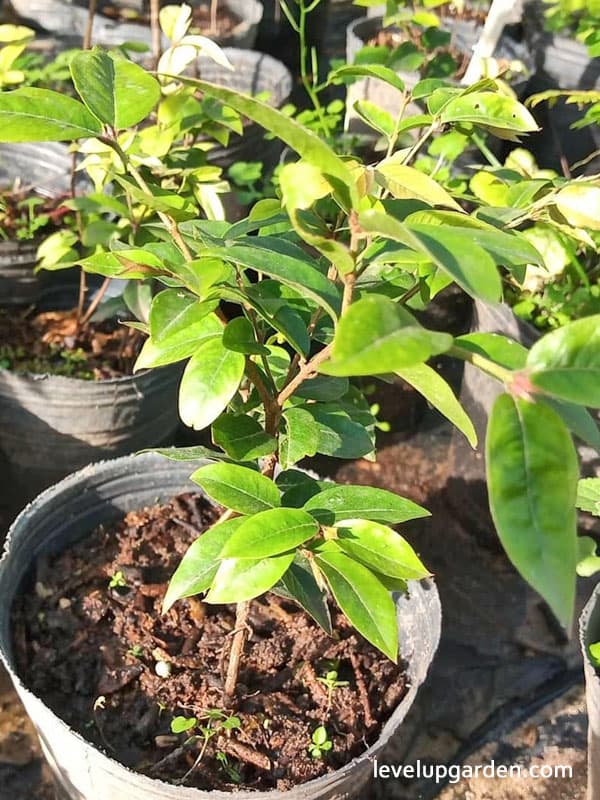
It is grown by many gardeners for its fruit. But, while the fruit has a unique flavor that makes it a favorite of many, the ornamental character of this plant is also noteworthy. The Jaboticaba has both flowers and fruit on the bark, covering most of the tree at certain times of the year. This effect makes it visually appealing throughout the four seasons.
The tropical jaboticaba produces white flowers through the bark, covering the tree with white petals that makes it look appealing. Shortly after flowering, the cottony flowers are quickly replaced by dark, fragrant berries. Jaboticaba grows with a light green skin at first, which eventually turns dark purple.
Moreover, the grape-like berries cover the entire tree, giving it a unique appearance. The harvested fruit is often eaten immediately as a fresh snack. Jaboticaba has a sour-sweet aroma like muscadine.
Jaboticaba will turn your garden into a tropical paradise with its refreshing fruit and unwavering beauty. The lush, beautiful foliage is on all year round, but the real highlights are revealed when the jaboticaba tree begins to shed its old bark. The layers of old gray bark peel away to reveal young, light brown or beige bark. This colorful bark stands out against the other dark green trees and is the center of attention with its stunning colors.
VI. FAQs
Can you grow Jaboticaba in USA?
Propagation is usually from seed, but grafting, root cutting, and air layering are also successful. Seeds germinate in about 30 days at an average temperature of 23°C. It can be grown in USDA cold hardiness zones 10-12.
What does Jaboticaba taste like?
They taste like grapes and come in many varieties. The most common is called red jaboticaba (but more purple in color), which tastes like blueberry yogurt. White jaboticaba tastes like sour lychee, and grimal jaboticaba tastes like grape candy. But these are just a few examples.
Is Jaboticaba good for you?
Jaboticaba juice is a powerful antioxidant, anti-inflammatory, and anti-aging agent known to improve skin health, lung capacity, digestion, cancer prevention, and overall health. It is also beneficial for asthma, heart health, and type 2 diabetes.
How fast do Jaboticaba trees grow?
Grafted seedlings bear fruit in three years, while seedlings bear fruit in eight to 15 years. Because of this slow growth, the spread of the plant has been slow.